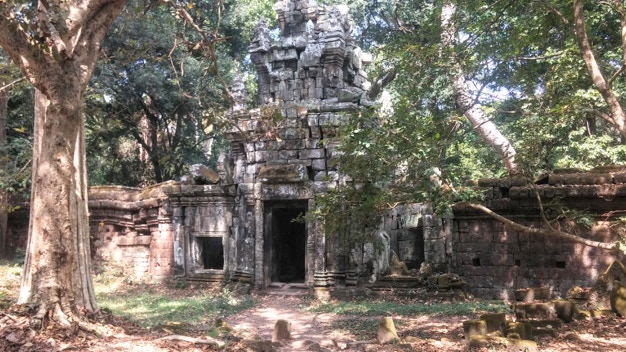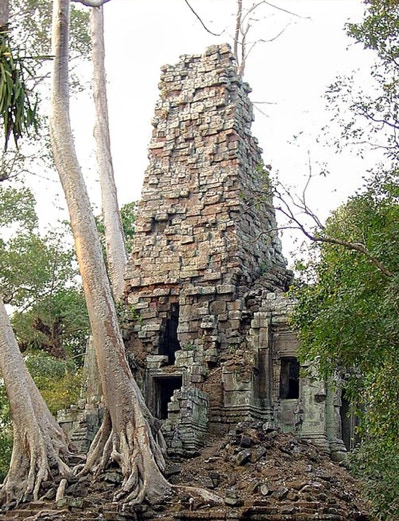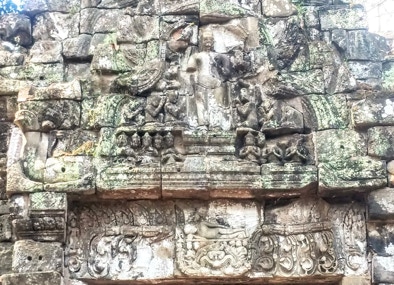
PREAH
PALILAY
(c. 1150)
GOPURA FROM ROYAL ENCLOSURE TO PREAH PALILAY (c.1150)

PREAH
PALILAY
(c. 1150)
GOPURA FROM ROYAL ENCLOSURE TO PREAH PALILAY (c.1150)
This inconspicuous gate in the north enclosure wall of the Royal Enclosure at Angkor Thom leads to the most remote temple in the capital, tucked into its far northwest corner. The key to its importance may lie precisely in its remote location in the least developed and frequented section of the capital. Today little remains of the shrine except the skeleton of its shikhara and a few pediments, yet it may have played a larger, if indirect, role in the religious history of Cambodia than any other temple at Angkor as the birthplace of Theravada Buddhism, the country's dominant faith for the last 700 years.

THE SHIKHARA FROM THE SOUTH, PREAH PALILAY (c.1150)

There are no records of the founding of Preah Palilay and it is dated largely on stylistic grounds to the period of Angkor Wat. From its bas reliefs, it seems always to have been a Buddhist shrine. It may date from the short and obscure reign of Dharindravarman II (1150-1160,) whose most important achievement may have been to have fathered Jayavarman VII (1181-1220.) If so, there might be reason to suspect he shared the religious sympathies of his son who made Buddhism the official religion of the Khmer Empire for the first time. Yet Jayavarman VII was influenced by Mahayana and Vajrayana Buddhist thought, while there is strong reason to believe Preah Palilay was a Theravada shrine. This might only reflect that father and son shared an inclusive attitude towards doctrinal differences. The temple's Theravada affiliation has been deduced solely from the fact that the temple was the only Buddhist monument at Angkor not defaced by the iconoclastic fury of the Hindu restorationist, Jayavarman VIII (1243-1295.) Since the established form of Buddhism had been Mahayana, that beleaguered and reactionary monarch may have seen Theravada as less a threat, even a competitor for the allegiance of the city's Buddhists, thought to have been concentrated mainly among its elite classes.
Theravada Buddhism was known as Hinayana or the “Lesser Vehicle” by followers of Mahayana, the "Greater Vehicle," who viewed it as a doctrinally less advanced form of the faith than their own "Second Turning of the Wheel of Dharma" or further revelation of Buddha's teaching, vaguely analogous to how New Testament writers regarded the Old. Its adherents, naturally, prefer to refer to themselves as Theravada, followers of "The Wisdom of the Elders," the true path to satori or enlightenment, fully contained in the "three baskets" or Tripitaka of the Pali Canon, recorded directly by Buddha's disciples; similarly, Mohammad is called the "seal of the prophets" in Islam, the final revelation of God's logos. Theravada disdains the proliferation of bodhisattvas and Buddhas appearing in the Mahayana sutras as "crypto-dualistic" and polytheistic and scorns the esoteric, sometime transgressive, occult rites of the Vajrayana lineages, as the result of the over-active, even heretical imaginations of their co-religionists. These distinctions are discussed at greater length in appendix IV, “The Three Turnings of the Wheel of Dharma,” in the introduction to this catalog.
PEDIMENT, PREAH PALILAY (c.1150)
Since Buddha is included in some lists of the Hindu Dashavatara, the ten incarnations of Vishnu, the temple's priests may not have challenged this attempt at co-optation of their prophet, hence making the shrine innocuous to Hindu zealots. In retrospect, of course, Preah Palilay proved something of a Trojan Horse which Jayavarman VIII let remain within the walls of his capital, since by 1327 Hinduism was no longer the state religion, replaced by Theravada Buddhism. This small and unprepossessing temple might therefore be regarded as its incubus. It does not, however, appear to have been revered as the place that faith first took root since it was never expanded and, in fact, abandoned when the capital was moved to Phnom Penh in 1431.
In the pediment (above,) one of the few in tact at the site, Buddha is depicted as a rather stout, standing figure, larger the Shiva and Vishnu were usually represented, and not as part of the narrative of the canonical events of his life which supply the subject for much Buddhist art. He is simply an imperturbable, remote but reassuring presence, as he is in Theravada worship, where belief in his teachings or dharma is the sole soteriological path. This pediment portrays Buddha surrounded by some of the early disciples who recorded the Pali Canon; the rather comic figure leering over his right shoulder may be the demon, Mara, who tempts the faithful with worldly desires embodied by his seductive daughters. Buddha's now-missing hands were probably raised, palm-forward in abhaya mudra, "the gesture of fearlessness and reassurance" and customary mudra for a standing figure. The torana or arch above his head ends with a five-headed naga, probably less a reference to Mukhalinda, the seven-headed naga who served as an umbrella in the weeks after Buddha's enlightenment, than an unshakable vestige of the long tradition of Khmer pediments stretching back to Preah Ko. The lintel below it also retains a traditional kala with a garland issuing from its jawless mouth The reclining figure above his grim grin is posed like countless Vishnus, asleep on the naga, Shesha or Ananta, in the "Empty Period" before Brahma emerges from his navel to create a new world. Here, however, it has been repurposed to represent the death of Buddha after a meal of spoiled pork (or mushrooms,) with his parinirvana or crossing into non-existence, the theological justification for the "sealing" of his dharma.
75